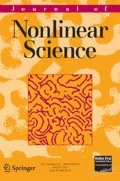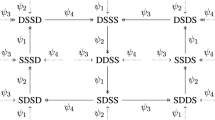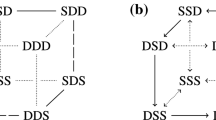Abstract
We analyze an example system of four coupled phase oscillators and discover a novel phenomenon that we call a “heteroclinic ratchet”; a particular type of robust heteroclinic network on a torus where connections wind in only one direction. The coupling structure has only one symmetry, but there are a number of invariant subspaces and degenerate bifurcations forced by the coupling structure, and we investigate these. We show that the system can have a robust attracting heteroclinic network that responds to a specific detuning Δ between certain pairs of oscillators by a breaking of phase locking for arbitrary Δ>0 but not for Δ≤0. Similarly, arbitrary small noise results in asymmetric desynchronization of certain pairs of oscillators, where particular oscillators have always larger frequency after the loss of synchronization. We call this heteroclinic network a heteroclinic ratchet because of its resemblance to a mechanical ratchet in terms of its dynamical consequences. We show that the existence of heteroclinic ratchets does not depend on symmetry or number of oscillators but depends on the specific connection structure of the coupled system.
Similar content being viewed by others
References
Aguiar, M.A.D., Dias, A.P.S., Golubitsky, M., Leite, M.C.A.: Homogenous coupled cell networks with S 3-symmetric quotient. DCDS Supplement, pp. 1–9 (2007)
Aguiar, M.A.D., Ashwin, P., Dias, A.P.S., Field, M.: Robust heteroclinic cycles in coupled cell systems: identical cells with asymmetric inputs. Preprint (2009)
Ashwin, P., Borresen, J.: Encoding via conjugate symmetries of slow oscillations for globally coupled oscillators. Phys. Rev. E 70(2), 026203 (2004)
Ashwin, P., Borresen, J.: Discrete computation using a perturbed heteroclinic network. Phys. Lett. A 347(4–6), 208–214 (2005)
Ashwin, P., Swift, J.W.: The dynamics of n weakly coupled identical oscillators. J. Nonlinear Sci. 2(1), 69–108 (1992)
Ashwin, P., Burylko, O., Maistrenko, Y., Popovych, O.: Extreme sensitivity to detuning for globally coupled phase oscillators. Phys. Rev. Lett. 96(5), 054102 (2006)
Ashwin, P., Orosz, G., Wordsworth, J., Townley, S.: Dynamics on networks of clustered states for globally coupled phase oscillators. SIAM J. Appl. Dyn. Syst. 6(4), 728–758 (2007)
Ashwin, P., Burylko, O., Maistrenko, Y.: Bifurcation to heteroclinic cycles and sensitivity in three and four coupled phase oscillators. Physica D 237, 454–466 (2008)
Busse, F.H., Clever, R.M.: Nonstationary convection in a rotating system. In: Müller, U., Roesner, K.G., Schmidt, B. (eds.) Recent Developments in Theoretical and Experimental Fluid Dynamics, pp. 376–385. Springer, Berlin (1979)
Ermentrout, G.B.: A Guide to XPPAUT for Researchers and Students. SIAM, Pittsburgh (2002)
Feng, B.Y., Hu, R.: A survey on homoclinic and heteroclinic orbits. Appl. Math. E-Notes 3, 16–37 (2003) (electronic)
Golubitsky, M., Stewart, I.: The Symmetry Perspective. Birkhäuser, Basel (2002)
Golubitsky, M., Stewart, I.: Nonlinear dynamics of networks: The groupoid formalism. Bull. Am. Math. Soc. (N.S.) 43(3), 305–364 (2006) (electronic)
Golubitsky, M., Pivato, M., Stewart, I.: Interior symmetry and local bifurcation in coupled cell networks. Dyn. Syst. 19(4), 389–407 (2004)
Guckenheimer, J., Holmes, P.: Structurally stable heteroclinic cycles. Math. Proc. Camb. Philos. Soc. 103, 189–192 (1988)
Hansel, D., Mato, G., Meunier, C.: Clustering and slow switching in globally coupled phase oscillators. Phys. Rev. E 48(5), 3470–3477 (1993)
Hofbauer, J., Sigmund, K.: Evolutionary Games and Population Dynamics. Cambridge University Press, Cambridge (1998)
Kiss, I.Z., Rusin, C.G., Kori, H., Hudson, J.L.: Engineering complex dynamical structures: Sequential patterns and desynchronization. Science 316, 1886–1889 (2007)
Kori, H., Kuramoto, Y.: Slow switching in globally coupled oscillators: Robustness and occurence through delayed coupling. Phys. Rev. E 63, 046214 (2001)
Krupa, M.: Robust heteroclinic cycles. J. Nonlinear Sci. 7(2), 129–176 (1997)
Krupa, M., Melbourne, I.: Asymptotic stability of heteroclinic cycles in systems with symmetry. Ergod. Theory. Dyn. Syst. 15, 121–147 (1995)
Kuramoto, Y.: Chemical Oscillations, Waves and Turbulence. Springer, Berlin (1984)
Melbourne, I.: Intermittency as a codimension-three phenomenon. J. Dyn. Differ. Equ. 1(4), 347–367 (1989)
Milnor, J.: On the concept of attractor. Commun. Math. Phys. 99, 177–195 (1985)
Milo, R., Shen-Orr, S., Itzkovitz, S., Kashtan, N., Chklovskii, D., Alon, U.: Network motifs: Simple building blocks of complex networks. Science 298, 824–827 (2002)
Rabinovich, M.I., Huerta, R., Varona, P., Afraimovich, V.S.: Generation and reshaping of sequences in neural systems. Biol. Cybern. 95, 519–536 (2006a)
Rabinovich, M.I., Varona, P., Selverston, A.I., Abarbanel, H.D.I.: Dynamical principles in neuroscience. Rev. Mod. Phys. 95, 519–536 (2006b)
Sakaguchi, H., Kuramoto, Y.: A soluble active rotator model showing phase transitions via mutual entrainment. Prog. Theor. Phys. 76(3), 576–581 (1986)
Sporns, O., Kötter, R.: Motifs in brain networks. PLoS Biol. 2(11), 1910–1918 (2004)
Stone, E., Holmes, P.: Random perturbations of heteroclinic attractors. SIAM J. Appl. Math. 50(3), 726–743 (1990)
Strogatz, S.H.: From Kuramoto to Crawford: Exploring the onset of synchronization in populations of coupled oscillators. Physica D 143, 1–20 (2000)
Zhai, Y.M., Kiss, I.Z., Daido, H., Hudson, J.L.: Extracting order parameters from global measurements with application to coupled electrochemical oscillators. Physica D 205, 57–69 (2005)
Zhigulin, P.Z.: Dynamical motifs: Building blocks of complex dynamics in sparsely connected random networks. Phys. Rev. Lett. 92(23), 238701 (2004)
Author information
Authors and Affiliations
Corresponding author
Additional information
Communicated by P. Holmes.
Rights and permissions
About this article
Cite this article
Karabacak, Ö., Ashwin, P. Heteroclinic Ratchets in Networks of Coupled Oscillators. J Nonlinear Sci 20, 105–129 (2010). https://doi.org/10.1007/s00332-009-9053-2
Received:
Accepted:
Published:
Issue Date:
DOI: https://doi.org/10.1007/s00332-009-9053-2
Keywords
- Synchronization
- Coupled oscillators
- Heteroclinic ratchet
- Asymmetric desynchronization
- Synchrony-breaking bifurcation




